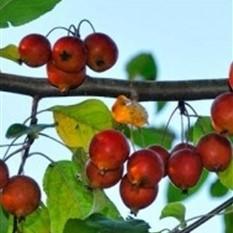The Callaway Crabapple, also known as Malus 'Callaway', is a popular ornamental tree known for its beautiful spring blossoms and attractive fruit. Here's some information about the Callaway Crabapple:
-
Appearance: The Callaway Crabapple is a small to medium-sized deciduous tree that typically reaches a height of 15 to 25 feet (4.5 to 7.5 meters) with a spread of 15 to 20 feet (4.5 to 6 meters). It has a rounded or spreading form with dense branching.
-
Flowers: One of the main highlights of the Callaway Crabapple is its profusion of showy flowers. The blossoms are typically pink or white and appear in clusters in early spring. They create a stunning display and attract pollinators like bees and butterflies.
-
Foliage: The leaves of the Callaway Crabapple are oval-shaped and medium green in color. They provide an attractive backdrop to the vibrant flowers during the growing season. In the fall, the foliage may turn shades of yellow, orange, or red, adding to the tree's visual appeal.
|
Type: |
|
|
Origins: |
Hybrid |
|
Height: |
10' - 15' |
|
Spread: |
10’ - 15' |
|
Spacing: |
12' |
|
USDA Hardiness Zone: |
4 - 8 |
|
Culture: |
|
|
Bloom Color: |
White |
|
Season of Interest: |
MAINTENANCE NEEDS: Medium Maintenance. Regular water in first year, planted in well draining soil, fertilize yearly. Watch for scab, fire blight, rusts, leaf spot and powdery mildew. Potential pests include tent caterpillars, aphids, Japanese beetles, borers and scale. Spider mites may occur.
LANDSCAPE USES: Accents or Group Plantings, Borders, Wildlife Gardens, Shade Tree, Edible Garden, and Container.
COMPANION PLANTS: Apple, Shasta Daisy, Bugleweed
IMAGE: Photo by Bottoms Nursery, Callaway Crabapple



















































